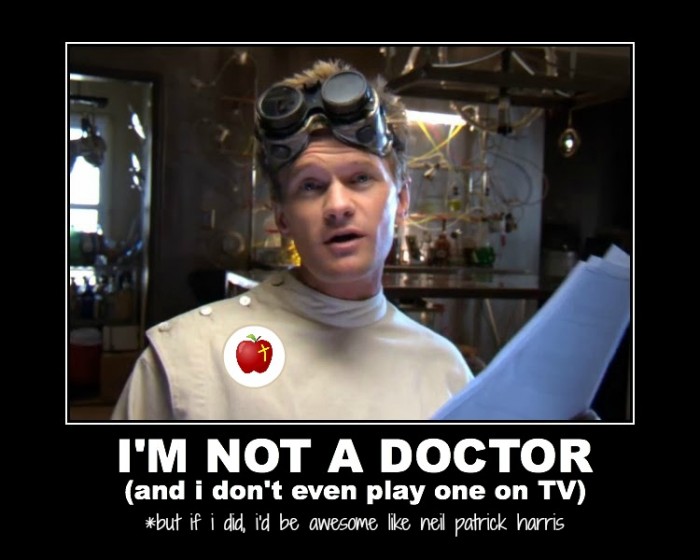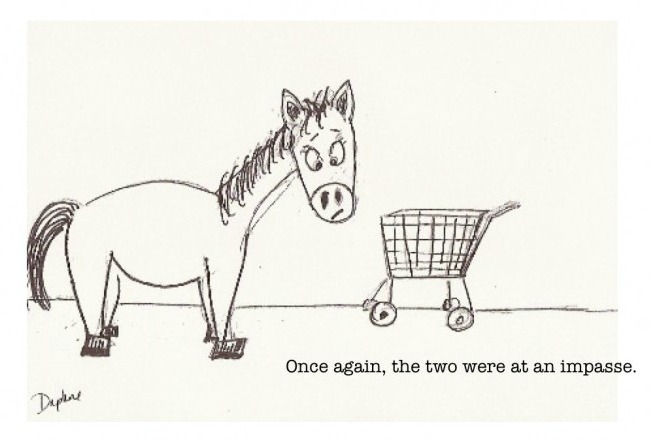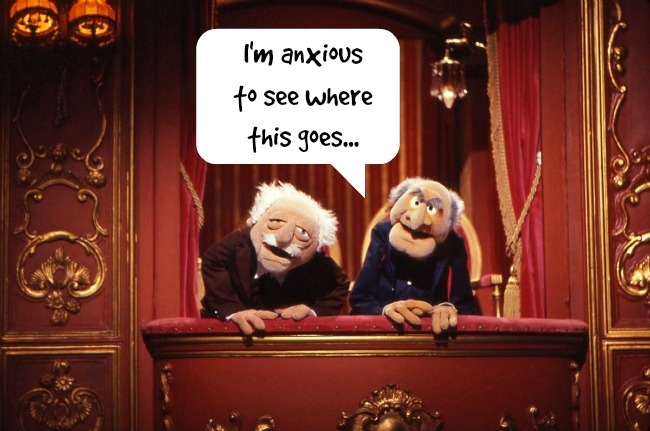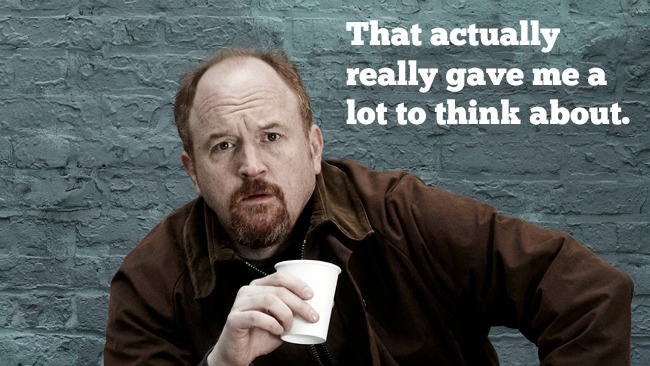If you’ve been following along since Monday, you know we’ve been on a bit of a “chemical imbalance” rant over here. (Don’t worry – the end’s in sight, I promise!) However, whether you’re new to the issue or have been breathlessly tracking every #HowDoYouKnow tweet, post and picture – and, unless you’re my mom (what up Sharon!), I think it’s safe to say you’re probably in the first group ;) lol – you likely all have the same question:
If depression isn’t caused by a “chemical imbalance”, why did my doctor tell me it is? And, BTW: What’s up with all those antidepressant commercials? You sound like a crazy conspiracy theorist!
(Ok, you’re hopefully probably not thinking that last part – but I totally get it if you are!)
I mean, I’m not a scientist, I’m not a doctor – so what the heck am I doing challenging this whole premise?!
Fair enough – but here’s the twist: I’m NOT challenging it!
I’m not trying to debunk the “chemical imbalance” theory of depression, because it’s already been debunked. (Ever notice how antidepressant commercials always say depression “may” be caused be a chemical imbalance? Or that depression is “thought” to be caused be a dysregulation of serotonin in the brain? From a strictly profit-driven perspective: Don’t you think the people trying to sell you a chemical imbalance cure would jump at the chance to shout from the rooftops that depression is caused by a chemical imbalance?)
But they can’t. Because it’s not.
Don’t take my word for it…
Now would probably be a good time to call in the experts!
- “Additional experience has not confirmed the monoamine depletion hypothesis” – The American Psychiatric Textbook of Clinical Psychiatry
- “A serotonin deficiency for depression has not been found” – Joseph Glenmullen, Harvard Medical School Professor
- “I spent the first several years of my career doing full-time research on brain serotonin metabolism, but I never saw any convincing evidence that any psychiatric disorder, including depression, results from a deficiency of brain serotonin. […] Some neuroscientists would question whether the theory is even viable, since the brain does not function this way, as a hydraulic system” – David Burns, Stanford psychiatrist
- “Although it’s often stated with great confidence that depressed people have a serotonin or norepinephrine deficiency, the evidence actually contradicts these claims” – Elliot Valenstein, Professor Emeritus of psychology and neuroscience, University of Michigan
(And one of my new favorites):
- “In truth, the ‘chemical imbalance’ notion was always a kind of urban legend – never a theory seriously propounded by well-informed psychiatrists” – Ronald Pies, Editor in Chief Emeritus of Psychiatric Times
So where did things go left?
*As with Part One and Two of this series, today’s post is going to draw heavily on Robert Whitaker’s award-winning book, Anatomy of an Epidemic (partly because his work is genius; partly because I’m super busy with my new move to Florida!). So if you like what you read, head on over to Amazon and pick up a copy :) It’s hands down one of the best books I’ve ever read!
Ok, so just to review:
Monday we talked about Thorazine – that nifty lil anesthetic compound that surgeons found induced “twilight states” and sent patients into “artificial hibernation” (you know, the same drug that was marketed in 1954 as a “miracle” treatment for mental disorders, kicking off the psychopharmaceutical revolution). Tuesday we talked about the social climate that set the stage: The whole country was buzzing with excitement over the discovery of new drugs, like penicillin – and psychiatry was in a hurry to catch up. Then BOOM. Thorazine starts selling like hotcakes, labs start pumping out new “minor” tranquilizers like Miltown, researchers stumble across iproniazid (leading to the first antidepressants!) and, just like that, psychiatry’s finally got the spotlight.
Only one problem: There still wasn’t any theory about what was causing mental disorders.
*I know I used this picture yesterday, but I just couldn’t help myself :) lol
Let’s get to the science!
Ok, so in 1955 (just wanna stress one more time: this was after the drugs were already on the market), researcher Bernard Brodie noticed something funny: When he gave rabbits reserpine (an herbal drug), the animals became “lethargic” and “apathetic.” Brodie also noted that their brain levels of serotonin were lowered. Arvid Carlsson, who previously worked in Brodie’s lab, soon reported that reserpine also lowered norepinephrine and dopamine (collectively known as catecholamines). However, if the animals were pretreated with antidepressants iproniazid (a.k.a. our rocket fuel friend from yesterday’s post!) and imipramine before being given reserpine, they didn’t become lethargic or apathetic. The drugs seemed to block resperine’s usual depletion of serotonin – planting the first seed of the “chemical imbalance” theory. (Depleted serotonin, apathetic bunnies. Kinda makes sense…)
In 1965, Joseph Schildkraut published a paper in the American Journal of Psychiatry setting forth the official chemical imbalance theory, proposing that “some, if not all depressions are associated with an absolute or relative deficiency of catecholamines, particularly norepinephrine”. The focus quickly shifted to serotonin, but the ball was basically in motion. (Side note: I feel like no one ever pays attention to the fact that Schildkraut even wrote in his paper, “[this hypothesis is] at best a reductionistic oversimplification of a very complex biological state”.) #sigh.
In 1969, Yale researcher Malcom Bowers became the first person to report on whether depressed patients actually had low levels of serotonin metabolites (5-HIAA) in their cerebrospinal fluid. In a study of eight people, his results showed that 5-HIAA levels were slightly lower, but not “significantly” so. In 1974, he tried again – this time finding that depressed patients who had not been exposed to antidepressants had perfectly normal 5-HIAA levels.
Things weren’t looking so hot for the chemical imbalance theory…
Then things got worse.
In 1974, Joseph Mendels and Alan Frazer revisited the evidence that led Schildkraut to suggest his theory in the first place. They found that resperine (remember, from the bunny study) didn’t reliably reduce depression. In fact, it actually lifted the spirits of some people!. And, on top of that, when researchers gave patients other serotonin-depleting drugs, those agents didn’t cause depression either!
It seemed like the whole theory was about to be tossed out with the trash, but then a study, one year later, brought it back to life:
In 1975, Marie Asberg and colleagues reported that 20 of the 68 depressed patients they tested suffered from low levels of 5-HIAA. This, it seemed, was the confirmation the pharmaceutical industry had been waiting for. However, researchers noticed a flaw after the fact…
Asberg failed to note in her discussion that even though 29% of her depressed patients had low 5-HIAA levels, 25% of her “normal” group did too! There was a bell curve for each group (normal and depressed) and both showed about the same variability. (It’s also worth noting that 24% of the depressed group actually had “high” levels of serotonin!!)
Despite the fact that numerous follow-up studies continued to disprove the theory (as the Essential Psychopharmacology textbook explains, “There is no clear and convincing evidence that monoamine deficiency accounts for depression; that is, there is no ‘real’ monoamine deficit”), antidepressant drugs (which, at this point, had been around for approximately twenty years) were so popular, no one seemed to care. In 1988, Prozac hit the shelves and the rest is, well, history!
So, so many questions!
I know it doesn’t seem fair to stop there (full disclosure: I just spent the past ten minutes typing a whole other section – and then deleting it – on antidepressant companies and findings from their own independent research), but today’s post packed in a lot of science – and honestly, I’m exhausted! (This Florida heat is no joke!)
Long story short: Antidepressants mess around with your serotonin – and, yeah, that affects how you feel – but there’s no known chemical imbalance before you start taking them. And they certainly aren’t restoring balance (Whitaker notes, it’s “precisely the opposite”). Antidepressants actually trigger a number of changes to your serotonergic system. As Princeton neuroscientist Barry Jacobs writes,
[These drugs] alter the level of synaptic transmission beyond the physiological range achieved under [normal] environmental/biological conditions. Thus, any behavioral or physiological change produced under these conditions might more appropriately be considered pathologic, rather than reflective of the normal biological role of 5-HT [serotonin].”
Ronald Pies, Editor in Chief Emeritus of Psychiatric Times – one of the most widely read psychiatric publications in the country – sums things up nicely:
I am not one who easily loses his temper, but I confess to experiencing markedly increased limbic activity whenever I hear someone proclaim, “Psychiatrists think all mental disorders are due to a chemical imbalance!” In the past 30 years, I don’t believe I have ever heard a knowledgeable, well-trained psychiatrist make such a preposterous claim, except perhaps to mock it. On the other hand, the “chemical imbalance” trope has been tossed around a great deal by opponents of psychiatry, who mendaciously attribute the phrase to psychiatrists themselves. And, yes — the “chemical imbalance” image has been vigorously promoted by some pharmaceutical companies, often to the detriment of our patients’ understanding.[…] The legend of the “chemical imbalance” should be consigned to the dust-bin of ill-informed and malicious caricatures.
Whew! Only two more posts to go!
Who would’ve thought blogging five days in a row would be so hard! lol :) Thanks so much for everyone who’s following along :) I can’t wait to share my research proposal with you guys on Friday!
Don’t forget, today’s post was paraphrased from Robert Whitaker’s book, Anatomy of an Epidemic – so if you’re super interested in this topic, definitely go grab yourself a copy! :)
And remember: All of this information is provided with the hope that you’ll be encouraged to ask your doctor #HowDoYouKnow next time he/she suggests that you, or a family member or friend, suffers from a “chemical imbalance”. Besides the fact that the chemical imbalance theory has been totally debunked, I can’t be the only person who thinks it’s strange that someone can just look at you and see what your chemicals are doing inside your brain ;)
See ya tomorrow!
Same time, same place!
xo Jessica ♥
Related Posts:
The Strange Start of Psychopharmacology (Part One)
A Funny Little Story About Rocket Fuel (Part Two)
Awkward, Your Chemical Imbalance is Showing
References
Bowers, M.B., Heninger, G.R. & Gerbode, F. (1969). Cerebrospinal fluid 5-hydroxyindoleacetic acid and homovanillic acid in psychiatric patients. International Journal of Neurophamacology, 8: 255-62.
Dubvosky, S., Davies, R., Dubvosky, A. (2003). Mood disorders. In R. Hales & S. Yudofsky (Eds.), The American psychiatric textbook of clinical psychiatry (4th ed.), (pp. 439-542). Washington, D.C.: American Psychiatric Press.
Glenmullen, J. (2001). Prozac backlash: Overcoming the dangers of prozac, zoloft, paxil and other antidepressants with safe, effective alternatives (p. 384). New York, NY: Simon and Schuster.
Lacasse, J.R., Gomory, T. (2003). Is graduate social work education promoting a critical approach to mental health practice? Journal of Social Work Education, 39(3): 383–408.
Lacasse, J.R. & Leo, J. (December 2005). Serotonin and Depression: A Disconnect between the Advertisements and the Scientific Literature. PLoS Medicine, 2 (12), p. e392.
Pies, R.W. (2011). Psychiatry’s new brain-mind and the legend of the “chemical imbalance”. Psychiatric Times.
Schildkraut, J.J. (1965). The catecholamine hypothesis of affective disorders: A review of supporting evidence. The Journal of Neuropsychiatry and Clinical Neurosciences, 7: 524-533.
Stahl, S.M. (2000). Essential psychopharmacology: Neuroscientific basis and practical applications, (p. 601). Cambridge: Cambridge University Press.
Valenstein, E. (1998). Blaming the Brain: The Truth about Drugs and Mental Health (p. 292). New York: Free Press.









Leave a Reply